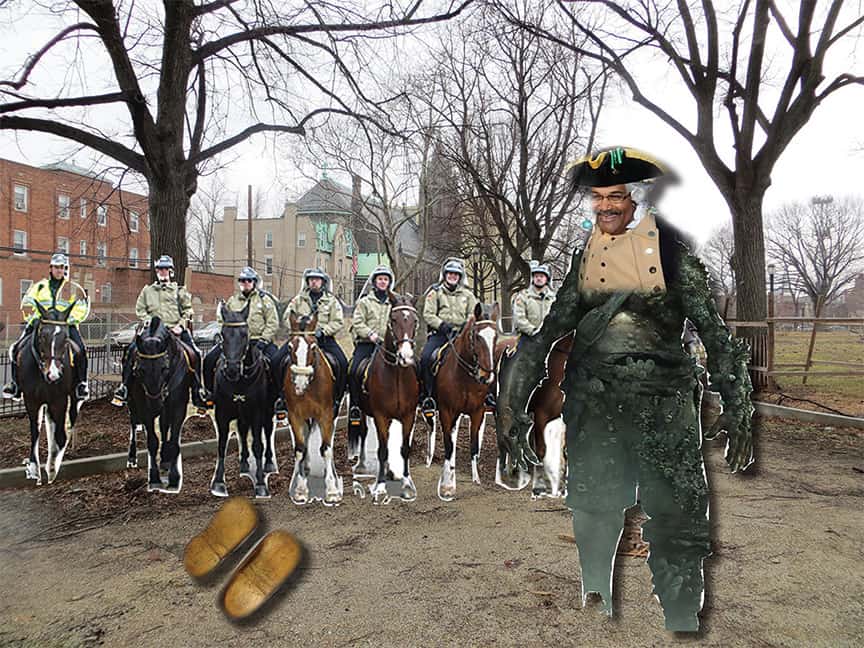The re-opening of Coffey Park was delayed for at least six months due to an unusual finding that occurred during renovation.
The park, Red Hook’s largest, was fenced off in April 2014 for a project that involved a repaving of the paths and improvement of the barbecue and flagpole areas. The community was told at the time to expect the park to be closed for one year.

The first aspect of the project involved the removal of the paving stones, that formerly served as the surface of the park paths. Over the years, they had broken and became unlevel due to tree roots and soil shifting. At least that was the original determination.
As the stones were taken out, a different scenario appeared before the contractors hired by the Parks Department to do the job. Not just different, but horrifying.
What was revealed to be under the paving stones were not tree roots at all – but the soles of ancient Dutch wooden shoes. And there was more to be found underneath the Dutch shoes!
History students will remember that New York was originally called Niew Amsterdam. This was because the original European settlers were not British at all… but Dutch. They came not only to settle in Manhattan, but Brooklyn as well. The common story is that Red Hook was so named because it is shaped like a hook, but the real story is that it was named Roode Hoek. Hoek, in Dutch, means point. The shape of Red Hook was different in those days, as all the land was not yet filled in. Back then the area of Coffey Park was a point that stuck into the harbor.
The Blue Pencil Lunar-Revue has recently learned that on August 17, 2014, a worker called his foreman at TBO Sitescapes, the Queens contractor doing the job. He explained exactly what he saw, and the foreman immediately placed a call to Brooklyn Parks Commissioner, Kevin Jeffrey.
Listening intently, Jeffrey immediately donned some appropriate clothing and hustled off to the park, cancelling his appointment with a designer of luxury outdoor bathrooms.
What the worker saw when he removed the paving stones was utterly shocking. All along the pathways, he saw antique Dutch wooden shoes, clogging upside down along the path. They were actually moving amidst the dirt, causing the paving stones to buckle in some locations, and to bulge out in others. When he attempted to pull out one of the shoes from the earth, he heard a blood wrenching scream!
Foreman, Joseph Skidlioski soon arrived. He tugged on the shoe and heard the same scream. Quickly assessing the situation, he made a 911 call. The nearby Red Hook Raiders, Engine Company 101 arrived right away, followed shortly afterwards by a Methodist Hospital ambulance.
Under cover of darkness, the firemen gingerly dug up the shoes and to the astonishment of all, brought up a gnarled old man. They sat him down on a nearby park bench, and the paramedics quickly went to work.
Amazingly enough the old man slowly opened his eyes and looked around. He dusted himself off and seemed amazed at what he saw – men with short hair, boots and red and white uniforms.
“Hawring, hawreeng,” he started saying, very slowly. The men around him were shocked to hear actual words – although they didn’t understand what he was trying to say.
“Hawring – gowanee. Gewanee heiring,” he repeated over and over.
The paramedics strapped him to a stretcher and took him to a private room at Methodist.
The whole thing was kept hush hush – until now. The old Dutch man was slowly nursed back to health. He developed an appetite. It was soon discovered that he especially craved oysters, pheasant and turkey meat.
Anthropologists and other scientists were brought to the hospital to try and figure out who this man was. Top doctors were called in to try and figure out what kind of human could survive life under paving stones. No answers were found, and no work was done at Coffey Park.
“Heirin – gowannee, gowanee heerien,” kept coming out of the old man’s withered mouth, day after day.
Finally, a young intern got the bright idea to call in someone who spoke Dutch. After all, the man was wearing wooden shoes when found. The NYPD Emergency Services Unit was contacted, and they sent in a detective with experience at dealing with international problems.
Two days later, Jasmin Pfeifer, a PhD researcher at the Amsterdam Center for Language and Communication at the University of Amsterdam was hustled off of a plane at JFK and driven to Methodist.
After a quick briefing, she went in to see the old man.
A crowd gathered in the hallway waiting to see what she could discover. After twenty minutes she came out and asked whether there was a creek somewhere near the park. “A creek called Gowanus,” she said.
It turned out that the old Dutch man, who somehow survived four centuries under Coffey Park, was lost trying to stock the Gowanus Creek (now Canal), with herring, a Dutch specialty.









4 Comments
OMG I loved it!!! At first I said..”Hmmmm wooden dutch shoes found under the stone…I was hoping they would be put on display THEN I said “Nah no way” LOLOLOL It got me at first..but anyway…APRIL FOOLS DAY….and boy was I fooled!!!!
Lol good one
I love exploring Red Hook because my mother’s family lived there in the 1930’s. She told me
how they would celebrate around the maypole in Coffey Park. You can see her church and
rectory in the background of the photo. My father and his brothers worked at Todd shipyard. It was filled in for IKEA.
I wish I had asked more questions about her life there. She’s 93 and doesn’t remember.
I absolutely loved the story. A history lesson mixed with a little mystery and intrigue. Again Loved it. Need to place a statue for the school children to gather around. When teachers have story time outdoors.
.